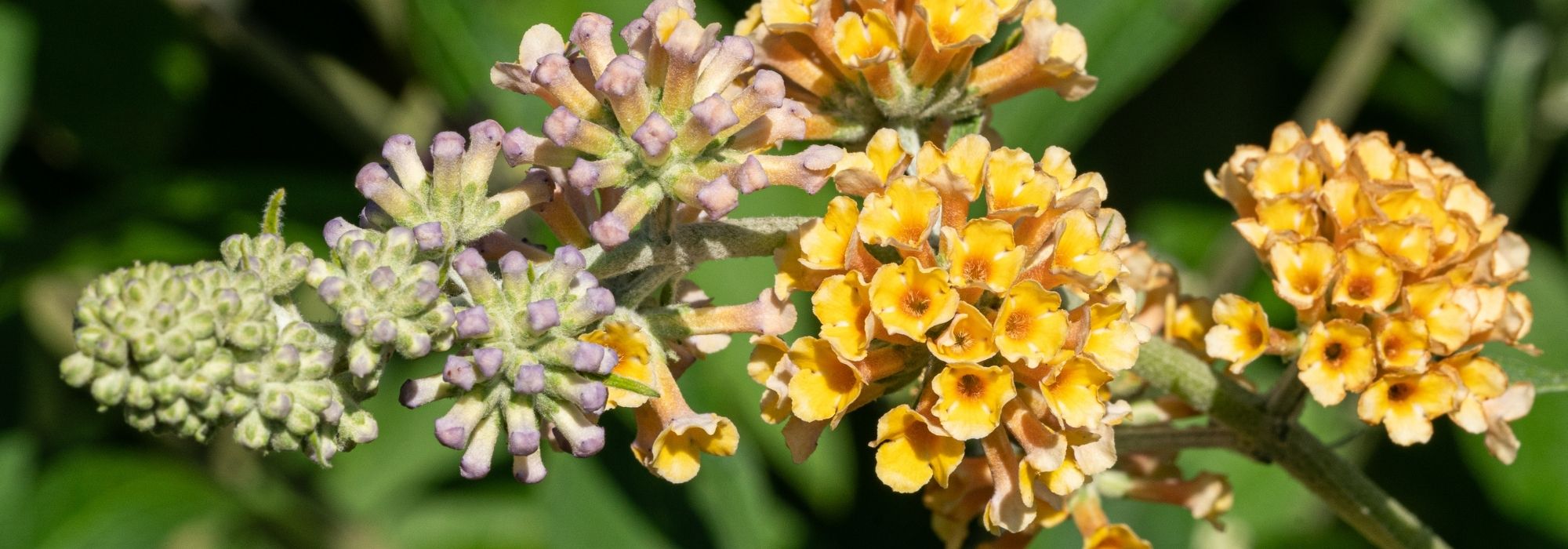
Drought-resistant bushes
A selection of bushes perfectly suited to dry soils
Contents
Heatwaves and water restrictions due to drought… These phrases are frequently heard, and things are unlikely to improve. Gardeners must adapt, adopt different gardening methods, and thus plant differently. Gone are the lush green lawns watered with drinking water, and gone are the water-hungry plants that will inevitably wither in these increasingly challenging conditions. Fortunately, nature is well-designed, and many plants are adapted to a lack of water. Among the many bushes, we offer our selection, all tested and approved in the garden. These are champions of sobriety, perfect for flowerbeds without watering!
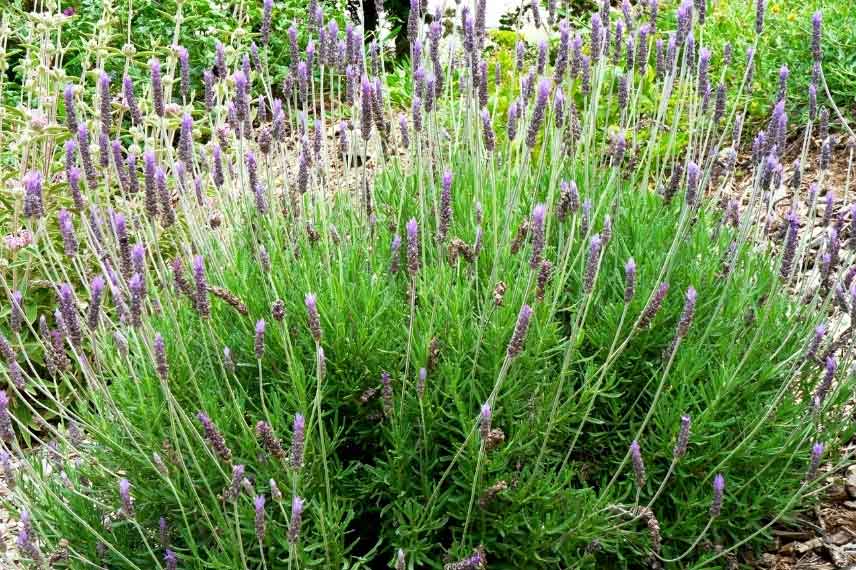
Many bushes are adapted to dry soil conditions
Buddleia weyeriana ‘Sungold’
Among butterfly trees, Buddleia weyeriana ‘Sungold’ stands out with its golden yellow colour and orange heart, while other varieties typically range in shades of mauve, fuchsia pink, or white. It is a very easy bush that tolerates even the most inhospitable soils. Its growth is very rapid, and its foliage is evergreen to semi-evergreen depending on climatic conditions. The lanceolate leaves are deep green and velvety on top. Its flowering extends from June to October-November and attracts bees and especially many butterflies. At maturity, it will reach between 2 and 4m. It prefers to be planted in full sun to flower generously. Unlike Buddleias davidii, it is not invasive. It flowers on the wood of the year, and faded inflorescences can be removed to encourage a longer flowering period. To add to its many qualities: it has exceptional hardiness!

Buddleia weyeriana ‘Sungold’
Read also
10 evergreen bushes for dry soilChilopsis linearis
The common name of this bush is “Desert Willow,” and for good reason! The Chilopsis linearis is a xerophytic bush, meaning it is adapted to a medium subjected to permanent aridity. It adapts to extreme drought conditions thanks to its root system that plunges deeply into the soil to reach underground water. In our gardens, it can grow between 3 and 4 m high, with an identical spread. Its growth is quite rapid if conditions are favourable: a light, sandy soil that is well-drained and a sunny exposure, even partial shade. It is perfectly hardy as it withstands temperatures down to -15°C in well-drained soil. Depending on the growing conditions where you welcome it, it will bloom from late spring to autumn with long, tubular carmine pink corollas. Its slightly weeping ramified habit and fine deciduous leaves give it a light and elegant appearance. A marvel!

Chilopsis linearis
Discover other Dry soil shrubs
View all →Available in 1 sizes
Available in 0 sizes
Available in 1 sizes
Available in 1 sizes
Available in 1 sizes
Available in 1 sizes
Available in 1 sizes
Available in 2 sizes
Available in 1 sizes
Available in 1 sizes
Grevillea
Originating from Australia, Grevillea are remarkably drought-resistant evergreen bushes that are highly floriferous. Their leaves are linear, resembling needles or the foliage of rosemary. Various varieties are of interest:
- Grevillea juniperina ‘Canberra Gem’, which flowers from March to July, developing to 2m in all directions.
- Grevillea rosmarinifolia, with rosemary-like foliage that flowers from February to June, reaching a similar size to the previous one.
- Grevillea rosmarinifolia ‘Rosa Jenkinsii’, featuring bright pink flowers in March-April and golden-green foliage. Its growth is slightly more compact, reaching 1m in height and width.
- The Grevillea lanigera ‘Mount Tamboritha’, a small groundcover bush of 15cm, which will spread in the foreground of your beds over approximately 1.5m and flower from February to May.
In general, Grevillea bear beautiful, finely cut flowers in vibrant colours ranging from red to fuchsia pink and are hardy down to -10°C in well-drained soil. Speaking of soil, Grevillea prefer well-drained, neutral or acidic conditions and tolerate drought without issue.
 Grevillea juniperina ‘Canberra Gem’
Grevillea juniperina ‘Canberra Gem’
Read also
12 bushes for dry or free-draining soilLavandula dentata
The most bushy and generous of lavenders! Commonly known as the dentate lavender or “French lavender” by English speakers, Lavandula dentata has a rounded bush habit, reaching 80 cm to 1 m in height and width, giving it a beautiful evergreen and flowering presence in borders. Its advantages include being both evergreen, perfectly adapted to drought, and flowering all year round in mild climates. An exceptional generosity, indeed, for this highly aromatic lavender with finely dentate leaves. It requires well-drained soil and a sheltered position in cooler climates to make the most of its flowers, ideally in full sun. Its frost resistance is down to -10°C, except in heavy, moisture-retaining soil. It also has the undeniable additional advantage of aging very well without forming old wood and requiring no pruning, other than the occasional removal of faded flowers to encourage the appearance of new ones.

Lavandula dentata
Leucophyllum frutescens
Commonly known as “Desert Sage,” this small evergreen to semi-evergreen bush thrives in dry, sandy or rocky, calcareous soil, and especially well-drained conditions. The Leucophyllum frutescens behaves like a desert zone plant, flowering with the first rain following a dry spell. Generally, this stunning flowering occurs in September-October. The bush then adorns itself with a multitude of tubular flowers with bright pink corollas, contrasting beautifully against the soft grey, fuzzy foliage. It can tolerate winter temperatures down to -10°C for short periods, provided the soil remains well-drained. To maintain a compact habit of just over 1m in all directions and prevent it from becoming bare at the base over the years, do not hesitate to prune the tips of the branches every autumn.
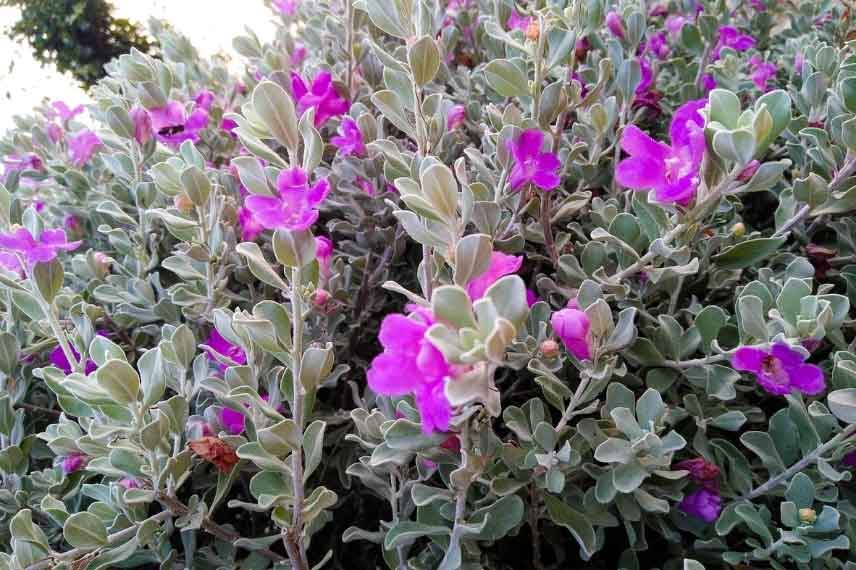
Leucophyllum frutescens
Myrtus communis ‘Tarentina’
Myrtle is one of the characteristic woody plants of scrub vegetation, consisting mainly of dense, evergreen vegetation that is resistant to drought. The foliage of myrtle, with its beautiful glossy green leaves, is remarkably aromatic. Myrtus communis‘Tarentina’ has an upright bushy habit, reaching just over 1.5 m in height and 1.2 m in width. With a rather slow growth rate, this myrtle bears small, tightly packed leaves along the stems and is very well suited to topiary pruning, making it ideal for creating dense hedges. It flowers in mid-summer, from July to September. Its star-shaped white flowers are highly attractive to bees and are followed by small edible black-blue berries that are sought after by birds. These berries were once used in cooking and for flavouring liqueurs. In terms of hardiness, it tolerates cold down to -10°C, and if you wish to adopt it in your garden outside the Mediterranean region, find a sheltered spot away from cold winds and ensure good drainage at the bottom of the planting hole.
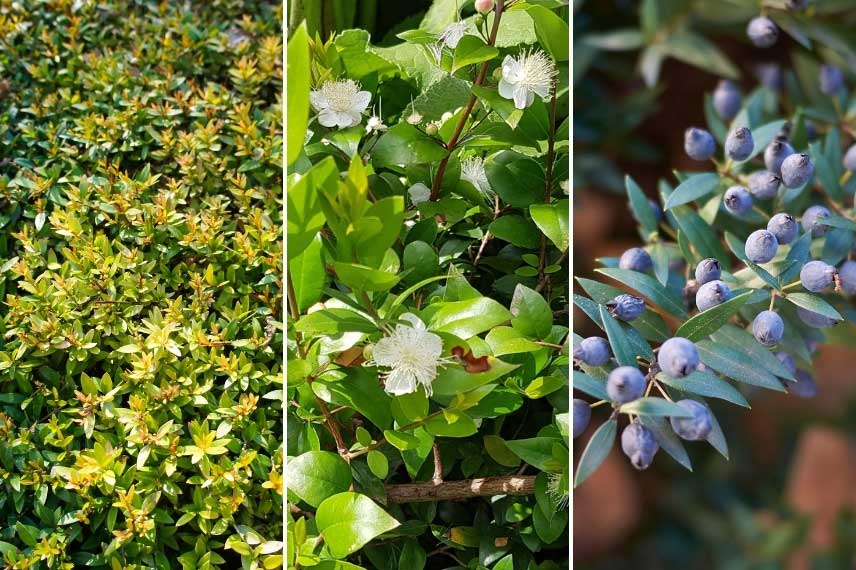
Myrtus communis ‘Tarentina’
Phlomis
Jerusalem sages are essential for dry gardens, as their cultivation is easy and their flowering is wonderful! I could tell you about Phlomis russeliana and Phlomis fruticosa with their golden yellow flowers or Phlomis purpurea with its lovely soft pink. These are evergreen shrubs, hardy down to -10°C, with fuzzy grey-green leaves and a dense, slightly spreading habit, growing from 80cm to 1.20m. The flowers are grouped in tiered clusters at regular intervals along the stems. They bloom from May to June-July, adding elegant splashes of colour to the garden. They thrive even in poor, stony soils, provided they are well-drained. For beautiful flowering over many years, it is best to plant them in full sun or partial shade.
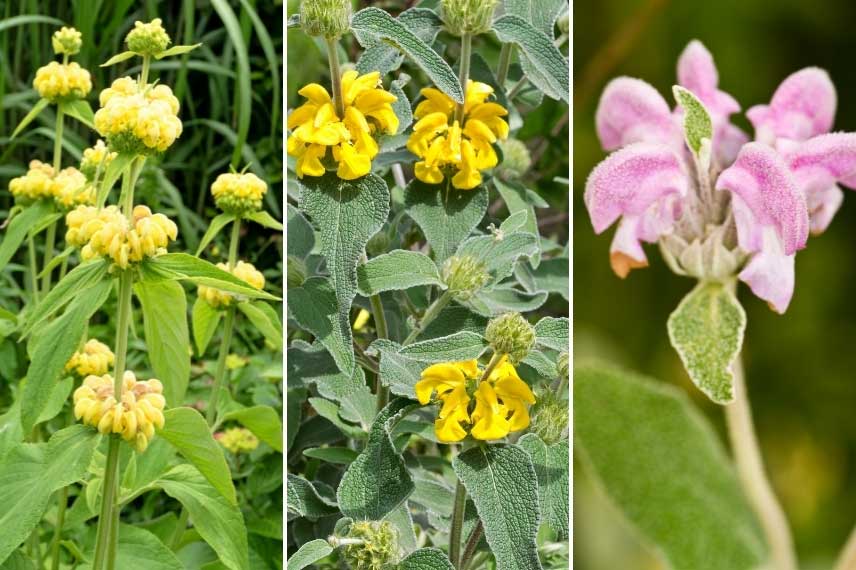
Phlomis russeliana, Phlomis fruticosa and Phlomis purpurea
Pistacia lentiscus
Recognisable by its strong resinous scent, the Pistacia lentiscus is a Mediterranean bush cultivated for its sap, still used today in medicine and cosmetics: mastic. It grows spontaneously in scrub vegetation and garrigue around the Mediterranean and is a valuable bush for dry gardens where it will adapt anywhere. With a rather slow growth rate, it displays attractive, rich green evergreen foliage that turns a purplish bronze in winter. It tolerates sea spray, withstands the poorest or clay soils, and thrives both in scorching sun and in the shade of taller plants. Highly long-lived, it ages well and responds admirably to pruning. However, young plants should be protected from the cold during the first few years, after which they can endure temperatures below -12°C.
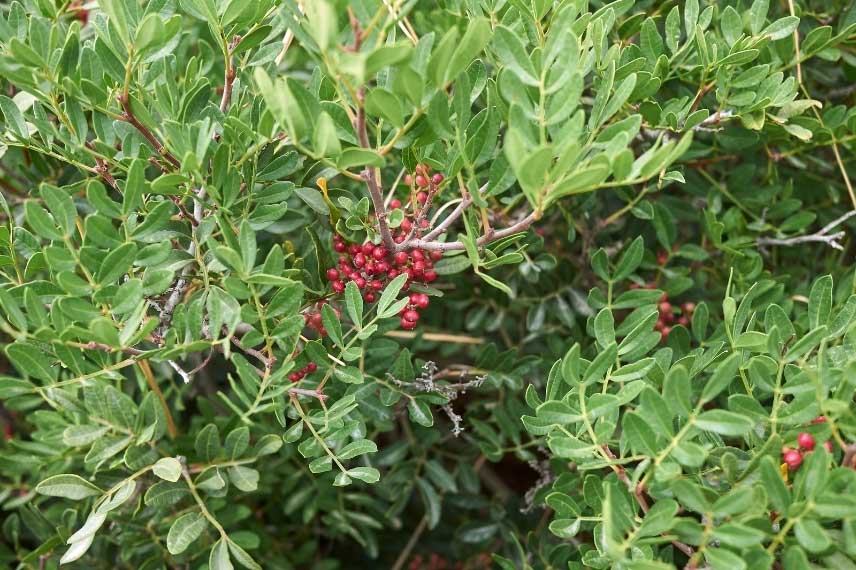
Pistacia lentiscus
Punica granatum
Remounting to the highest antiquity, the cultivation of the Pomegranate is still in vogue today, with its taste properties and health benefits being undeniable. Introduced by the Moors in Spain, where it was planted alongside myrtle and rose in the Gardens of the Alhambra, it gave its name to the city of Granada. In the garden, if one wishes to enjoy this beautiful bush suited to dry soil and its easy fruit production, one can plant fruiting varieties such as:
To enjoy only their stunning flowering, one should choose from the flowering varieties:
- Punica granatum ‘Maxima Rubra’ with large double bright red-orange flowers
- Punica granatum ‘California Sunset’ with beautiful crumpled double orange flowers, variegated with cream white
- Or the small Punica granatum ‘Nana’, which produces lovely small bright orange flowers and a few tiny fruits.
Except for the last mentioned, pomegranates reach a height of 3 to 4m with fairly rapid growth, and a spread of 3m. They naturally have an upright bushy habit and respond well to pruning, which can allow them to be trained as standards or half-standards for a more elongated silhouette. Their great quality is that they are very undemanding regarding soil type and withstand drought well. Nevertheless, occasional watering can lead to more generous flowering and fruiting. In terms of hardiness, they can tolerate temperatures around -10°C.
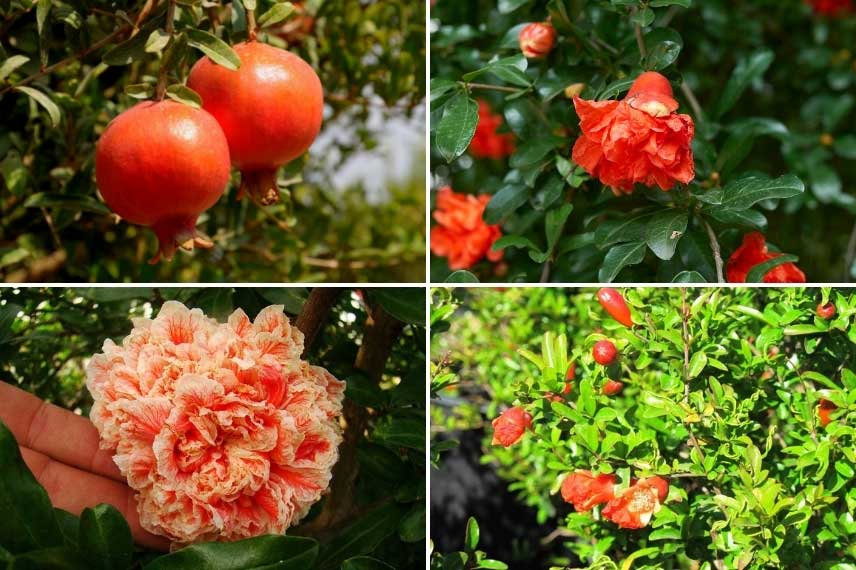
Punica granatum ‘Wonderful’, Punica granatum ‘Maxima Rubra’, Punica granatum ‘California Sunset’ and Punica granatum ‘Nana’
The China Rose 'Mutabilis'
A very easy botanical rose, whose variety name ‘Mutabilis’ means “that changes colour.” Rosa chinensis ‘Mutabilis’ forms a bush with beautiful dark green glossy evergreen leaves. The young shoots are red, followed by simple and slightly fragrant flowers, first yellow then shifting to coppery pink and finally dark pink. It produces a profusion of flowers from April to June, then a bit more sporadically in September-October after a rainy spell, and they reappear in numbers at Christmas! This large bush rose has few thorns and will thrive in soft, fairly deep soil, reaching over 2m in height and width. It tolerates drought very well, prefers full sun, although it can also be planted in partial shade. Winter temperatures do not scare it, as it withstands down to -15°C.

Rosa chinensis ‘Mutabilis’
Vitex agnus-castus
Commonly known as “Chaste Tree,” this beautiful bush can reach heights of 1.5 to 4m depending on the variety. In terms of silhouette, it is rather slender, an impression enhanced by its lovely upright floral spikes that appear from June to August.
- For Vitex agnus castus ‘Latifolia’, they are a beautiful deep lavender blue.
- Pure white for Vitex agnus-castus ‘Albus’.
- Dark violet for the more compact variety Vitex agnus-castus ‘Blue Puffball’, which will not exceed 1.10m, and for Vitex agnus-castus ‘Delta Blues’.
- Bright pink for Vitex agnus-castus ‘Pink Pinnacle’.
- And finally, deep lavender blue contrasting with purple foliage for Vitex agnus-castus ‘Flip Side’.
Chaste Trees are also known as “Monk’s Pepper” because their aromatic berries, resembling peppercorns, have an anaphrodisiac effect and were commonly planted near convents and monasteries. They are indifferent to the nature of the soil where the gardener installs them, tolerating limestone, saline soils, and sea spray well, preferring full sun and resisting drought very effectively. Cold does not bother them at all, and they will tolerate temperatures down to -12°C.

Vitex agnus castus ‘Latifolia’, Vitex agnus-castus ‘Albus’ and Vitex agnus-castus ‘Pink Pinnacle’
- Subscribe!
- Contents
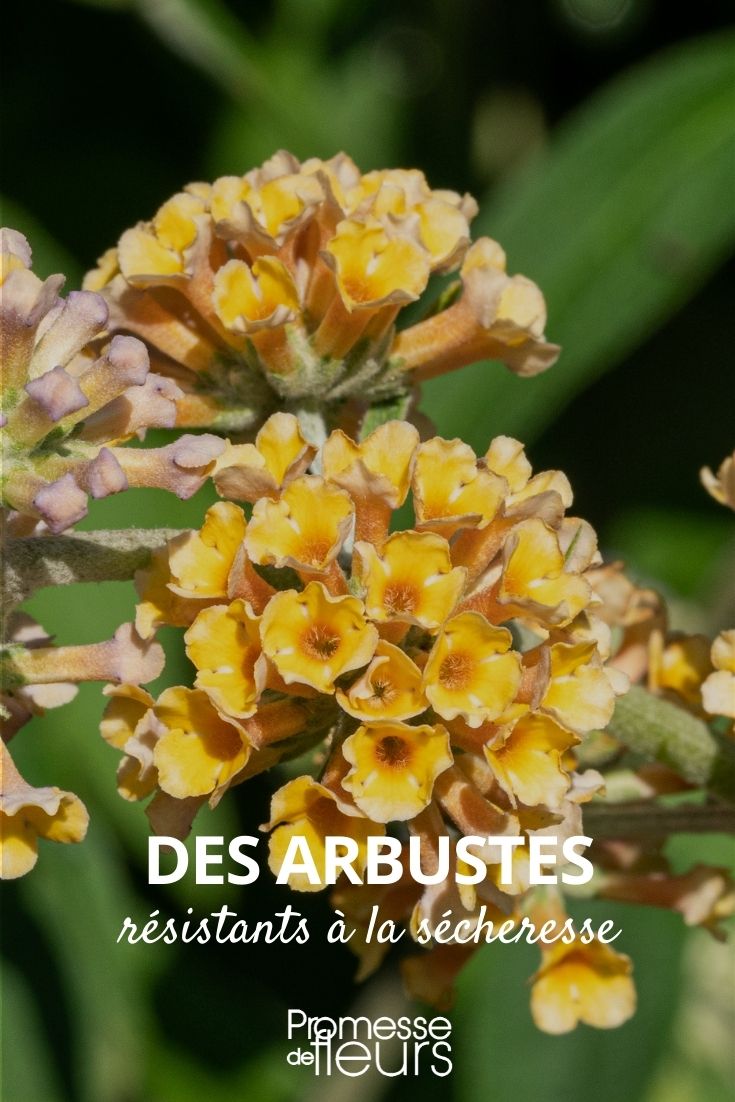































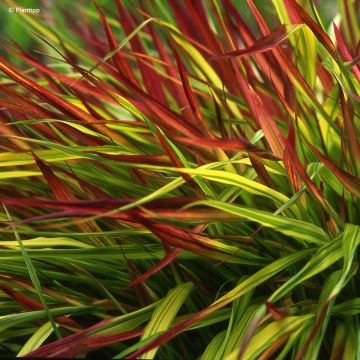

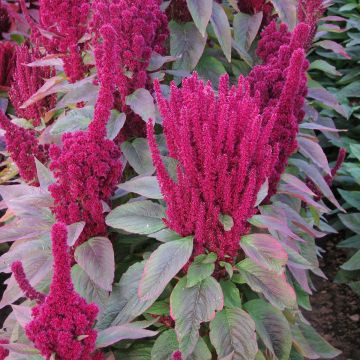
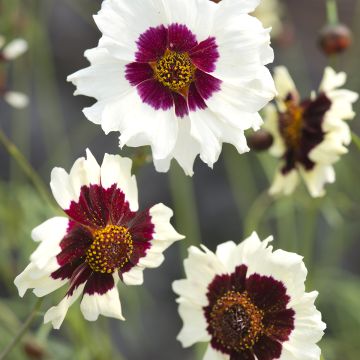
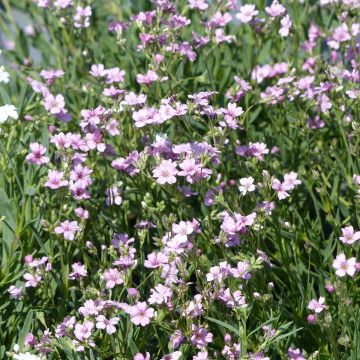
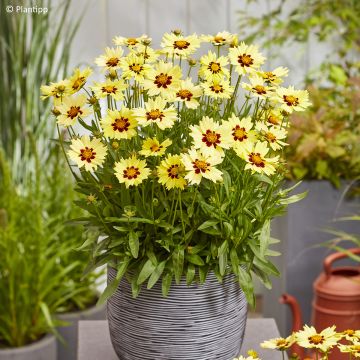
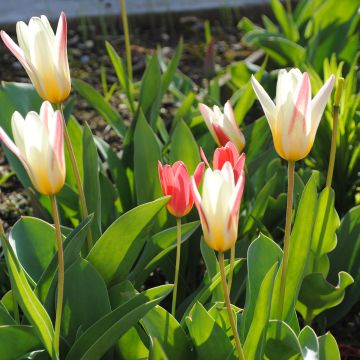


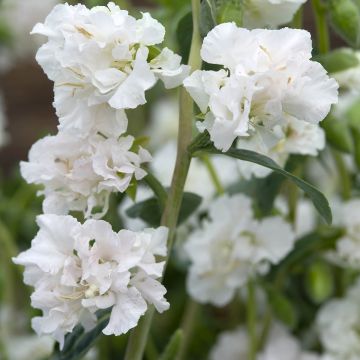
Comments